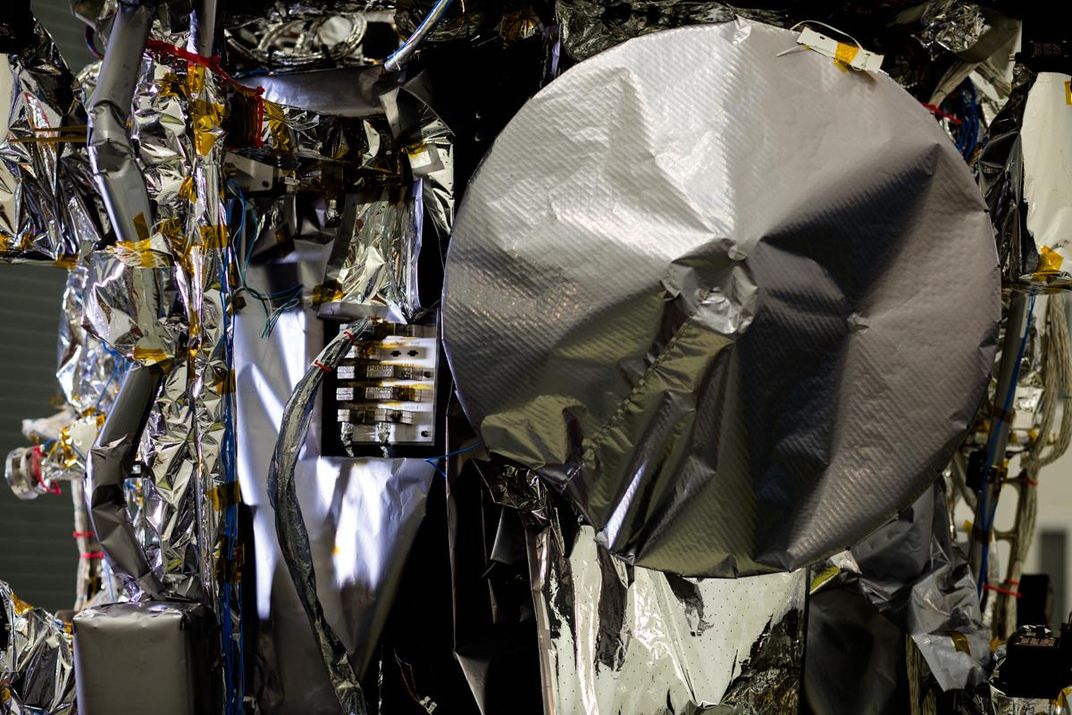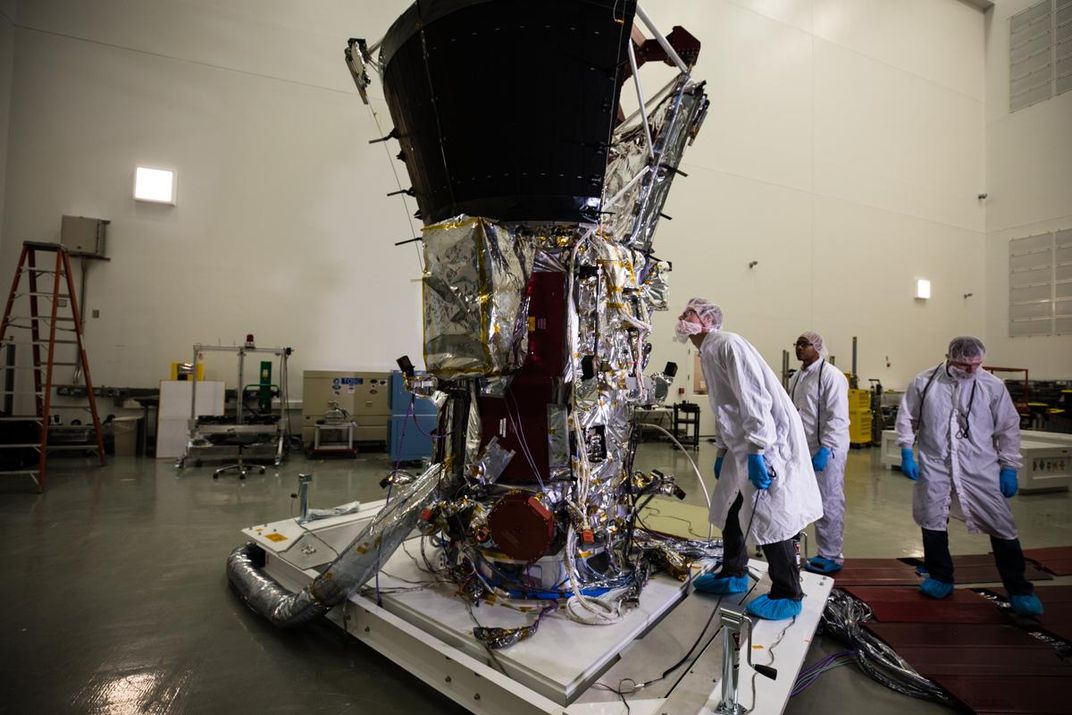Behind the Scenes With the Spacecraft That Will Soar Through the Sun’s Atmosphere
The probe, which launches Sunday, will attempt to solve enduring mysteries about the sun
:focal(520x457:521x458)/https://tf-cmsv2-smithsonianmag-media.s3.amazonaws.com/filer/82/14/8214a064-7052-42b6-8fd9-ecba7e6768dc/pspsoluri_is4a0285.jpg)
Update, August 11, 2018, 8 a.m.: NASA has delayed the launch of the Parker Solar Probe until the morning of Sunday, August 12, with a new launch window to begin at 3:31 a.m. EDT. The probe was originally scheduled to launch before sunrise on Saturday but due to a glitch involving a helium pressure anomaly with the the spacecraft's Delta IV Heavy rocket, the attempt was scrubbed minutes before scheduled liftoff. The latest the probe can commence its journey in 2018 will be August 23, as it relies on flybys of Venus to reach the sun. Otherwise, the probe will launch next May.
The Parker Solar Probe, set to launch on August 11, will be humankind’s first-ever contact with our closest star.
Prior spacecraft have admired the sun from afar, as the star’s searing temperatures have prevented in-depth study of its surface. Now, equipped with a state-of-the-art thermal protection system—including what may be the world’s most technologically advanced sun visor—the Parker Solar Probe is slated to make history.
The probe’s seven-year mission has several objectives. First, the probe will gather more information on solar winds—streams of plasma and particles emitted from the sun’s surface. These winds accelerate to speeds of about 250 miles per second as they are jettisoned from their star. Once in space, they travel hundreds of millions of miles, spewing past Earth in a constant stream. The only reason we don’t feel the buffeting is Earth’s magnetic field, which deflects the winds like a boulder in a coursing river. But how the winds ultimately break away from the sun’s gravitational pull remains mysterious.
This particular line of inquiry hits home for long-time admirers of our closest star. Solar winds were first described in the late 1950s by the probe’s namesake, physicist Eugene Parker; now, at age 91, Parker may yet hear the answers to his 60-plus years of scientific inquiry.
Second, the probe will be the first to make contact the sun’s corona—the chaotic, swirling outer atmosphere visible to the naked eye during a solar eclipse. For some reason, the corona is a halo hotter than the head it surrounds, blazing at temperatures up to 2 million degrees Fahrenheit—a couple orders of magnitude above the sun’s (often volatile) surface temperature of about 10,000 degrees Fahrenheit (which, to be fair, is still no walk in the park). It’s as counterintuitive as it sounds—like jerking your hand away from a flickering candle only to feel an even more scorching burn.
Third, the probe will investigate the acceleration of high-energy particles away from the sun’s surface. The fastest of these particles leave solar winds in the dust, blazing by at rates over 100,000 miles per second (sometimes encroaching on the speed of light). In fact, these particles are often associated with events such as solar flares (blindingly bright spots of energy exploding off the sun's surface) or coronal mass ejections (fiery belches of plasma spewing off the sun), both of which can damage satellites and even cause power outages on Earth. Scientists hope the probe's ventures will inform how the volatile corona manages to buoy both solar winds and these high-energy particles into space.
“We’ve been waiting 60 years for this mission,” says Nicola Fox, Parker Solar Probe’s project scientist. “It’s answering questions that have plagued scientists since we discovered the corona was superheated. It’s a true voyage of discovery.”
Although the probe has to close the 93-million-mile gap between Earth and the sun, its trajectory won’t exactly be direct. Spacecraft launched from Earth start with the same forward momentum as the planet itself, so the probe can't head straight into the inferno. Instead, the probe will spend the next seven years in a slow waltz of tightening ellipses around the sun, narrowing the gap between itself and its fiery dance partner with each passing year. To stay on course, Parker Solar Probe will occasionally hitchhike alongside Venus in a spacecraft-planet sashay that Betsy Congdon, lead engineer for Parker Solar Probe’s heat shield, compares to a “handbrake turn.” By co-opting the tug of Venus’ gravity, the probe can stabilize and reorient its path.
The probe’s journey will culminate in a final approach to the star in late 2024, during which it will come within 3.83 million miles of the sun’s surface. While this may still sound distant, this is seven times closer than any spacecraft has ever been to the sun—and closes about 96 percent of the distance between Earth and its star. What’s more, this will plant the spacecraft firmly within the scorching corona.
That's where the heat shield comes in. The designs have been nearly a decade in the making, and will be all that stands between the probe and the parching perils of its groundbreaking journey. But the task has been a bit more daunting than plopping a sun hat on the 1400-pound spacecraft.
At only 4.5 inches thick, the heat shield has a squishy carbon-foam core that is actually 97 percent hollow—making the structure something of an air sandwich. Still, the team’s lovingly nicknamed “eight-foot Frisbee” clocks in at 160 pounds. On either side are two panels made of a carbon composite which actually becomes more sturdy when heated. Additionally, the sun-facing side is coated in a specialized white paint that dissipates most of the sun's heat, guarding the fragile instruments below. The paint is essentially the most heavy-duty sunscreen ever invented—and it’s critical that not a spot is missed.
At the probe’s closest approach, the top of the shield will bake at about 2500 degrees Fahrenheit—over seven times the temperature required to roast a Thanksgiving turkey—but still surprisingly chilly considering its surroundings. The discrepancy has to do with the diffuseness of particles in the corona’s atmosphere: The majority of the heat the Probe will experience will actually come from the sun’s (comparatively chilly) surface, simmering a few million miles away. “If you stick your hand in an oven, it won’t burn,” Congdon explains. “That’s only when you touch the surface.”
As it endures these sweltering temperatures, the “giant Frisbee” will keep the rest of the probe as cool as a (lukewarm) cucumber. The backside of the shield will stay at 600 degrees Fahrenheit, and the instruments cloaked within the probe’s bus will remain around 85 degrees Fahrenheit. To ensure that the sensitive electronics remains in shadow, the heat shield must always face the sun. One misstep could end the long-awaited mission in a matter of seconds.
But the team has taken precaution upon precaution to preclude this possibility. Seven specialized sensors (sometimes referred to as “solar limb sensors”) surround the spacecraft, constantly sampling the probe’s exposure to light. If the spacecraft teeters into a precarious position, the sensors will trigger a protective response to rapidly correct the probe’s angle. The probe also comes with a liquid cooling system, packing in five liters of pressurized water that can trickle along little veins along the machinery to maintain a workable ambient temperature. The team’s meticulous engineering has been woven into every nook and cranny of the spacecraft. “She basically looks after herself,” says Fox.
As the “most autonomous spacecraft” ever built, the probe needs to jam a lot of machinery into a comparatively small package, says Annette Dolbow, the Parker Solar Probe’s integration and testing lead (the probe is about the size of a small car). Once the spacecraft launches, it will essentially cut all ties with its caretakers on Earth—meaning it’s up to this plucky probe to fend for itself over the next seven years. Since October 2012, Dolbow has fussed lovingly over the probe like an anxious parent to ensure its safe passage.
/https://tf-cmsv2-smithsonianmag-media.s3.amazonaws.com/filer/a4/40/a4401177-c398-41d9-a1b4-b4875d2f02dc/dr_nicola_foxsoluri_is4a0085.jpg)
Of course, there’s more to the probe than futuristic sunblock: It has some serious business to attend to. Alongside its safeguards, the spacecraft will sport instruments like the Solar Probe Cup, designed to scoop up the high energy particles streaming from the sun’s surface, and a set of telescopes to snap sunlit photos of the sights.
And the probe is certainly not planning to waste the wealth of solar power it will be privy to in its travels: After all, it will be seeing a lot of the sun. When it’s still far from the star, the probe will cast its solar panels wide, soaking in the star’s energetic rays to power its instruments. But as it approaches, the panels will tuck inwards like a sleeping bird’s wings, drastically reducing the amount of light they absorb. At closest approach, the sun’s power will be 475 times what a satellite orbiting Earth would experience—this is, as Fox puts it, “a heck of a lot of power” that could overwhelm the system’s sensitive electronics.
Congdon, Dolbow and Fox are all adamant that the probe could not have come together without the immense collaborative effort of NASA and Johns Hopkins Applied Physics Laboratory’s scientists, technicians and coordinators. The team and their collaborators have translated decades of planning from human minds onto sheets of paper and PowerPoint slides—now fully realized in a tangible feat of never-before-seen mechanics.
Dolbow’s group in particular has dedicated a staggering number of hours to the probe’s construction: “Most projects may get 300 to 500 hours on the hardware,” Dolbow explains. “Ours had almost 5000 hours on all our subsystems… but [the team] is still smiling. They take such pride in what they’ve done.”
After the probe’s launch, Dolbow jokes that she may notice her empty nest: “After it’s over, there will be a period that I’m not looking forward to… when we all go off and do separate things again. But it’ll be awesome that the spacecraft is in space, where it belongs. I’ll recover.”
As our closest star, the sun is our best proxy for understanding these celestial bodies as a whole. What’s more, the sun’s become a pretty critical part of our existence here on earth—but no star is built to last forever. Acquiring a clearer understanding of the sun’s health and temperament will serve not only the future of space exploration, but also the nature of life on our own planet.
“This mission is a little bit of everything,” says Fox. “It’s historical, it’s doing fundamental physics—but it’s also providing a benefit to life and society as a whole.”
With the launch just days away, Dolbow marvels that years of hard work have finally come together. “Here we are in the championship game, and we’re about to cross into the end zone,” she says. “It’s become such a family.”
The Probe will depart from Cape Canaveral Air Force Station in Florida this Saturday, with a launch window starting at 3:33 a.m. EDT. Its surge into the atmosphere will illuminate still-dark skies—an historic flare that precedes even the morning’s rising sun.
/https://tf-cmsv2-smithsonianmag-media.s3.amazonaws.com/accounts/headshot/10172852_10152012979290896_320129237_n.jpg)
/https://tf-cmsv2-smithsonianmag-media.s3.amazonaws.com/filer/53/5b/535b6fb5-9d77-4664-b700-c4039901cfe8/annette_dolbow_pspsoluri_is4a8971.jpg)
/https://tf-cmsv2-smithsonianmag-media.s3.amazonaws.com/filer/2b/1f/2b1feed4-5e30-470b-b910-bc98f723a417/parker_solar_probe_thermal_protectionshieldmsoluri.jpg)

/https://tf-cmsv2-smithsonianmag-media.s3.amazonaws.com/filer/49/07/4907aea0-a8c4-46f1-aab2-9c9f1365bf3e/parker_solar_probe.jpg)
/https://tf-cmsv2-smithsonianmag-media.s3.amazonaws.com/filer/fd/ab/fdab974e-1bad-4f00-bdb9-4b2efb0d645f/pspsoluri_is4a0240.jpg)
/https://tf-cmsv2-smithsonianmag-media.s3.amazonaws.com/filer/f3/a2/f3a260e6-2d23-4441-a2e8-8224c7ab0148/elizabeth_congdonsoluri_is4a0372.jpg)
/https://tf-cmsv2-smithsonianmag-media.s3.amazonaws.com/filer/ac/e2/ace24b22-f725-4197-a6d6-da24dcc95feb/pspsoluri_is4a0427.jpg)
/https://tf-cmsv2-smithsonianmag-media.s3.amazonaws.com/filer/d0/0a/d00a9c4b-02df-4d1c-888d-b261eaeb9a04/pspsoluri_is4a0457.jpg)

/https://tf-cmsv2-smithsonianmag-media.s3.amazonaws.com/accounts/headshot/10172852_10152012979290896_320129237_n.jpg)